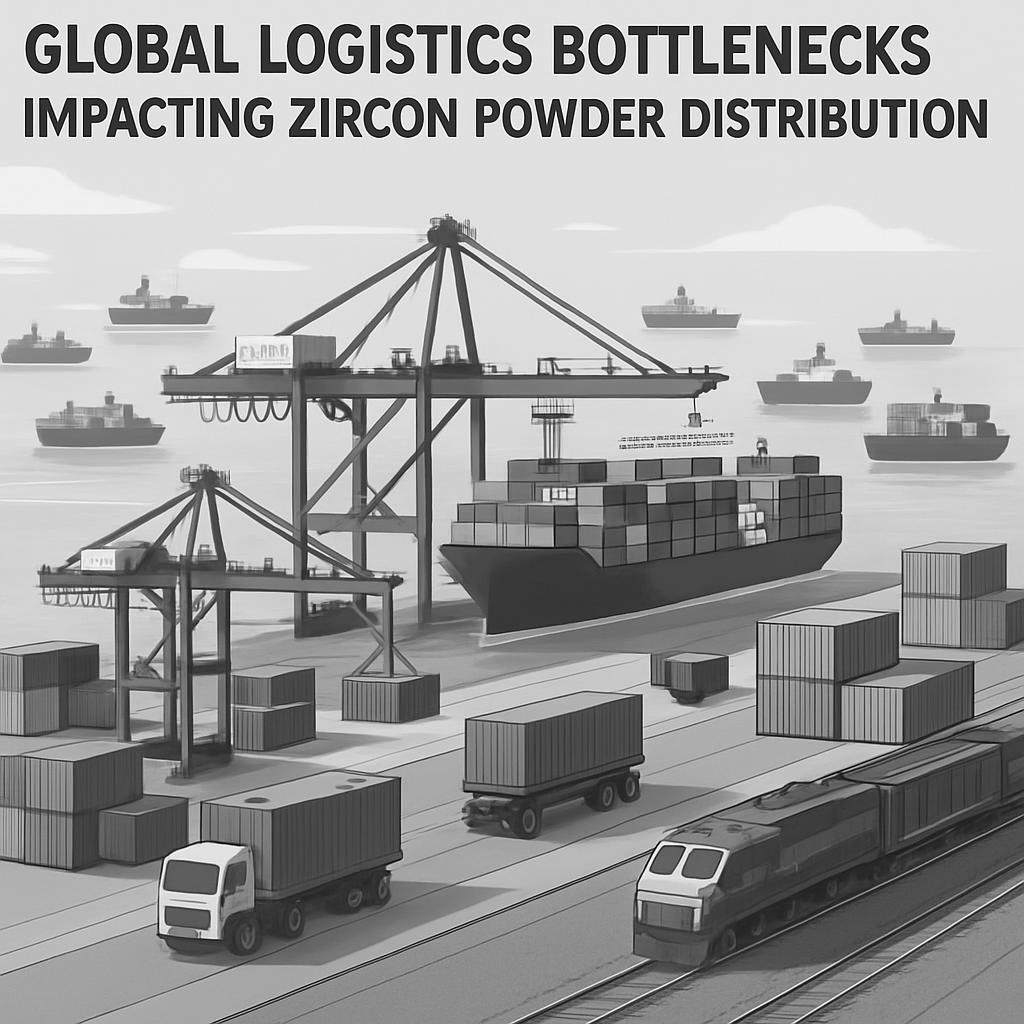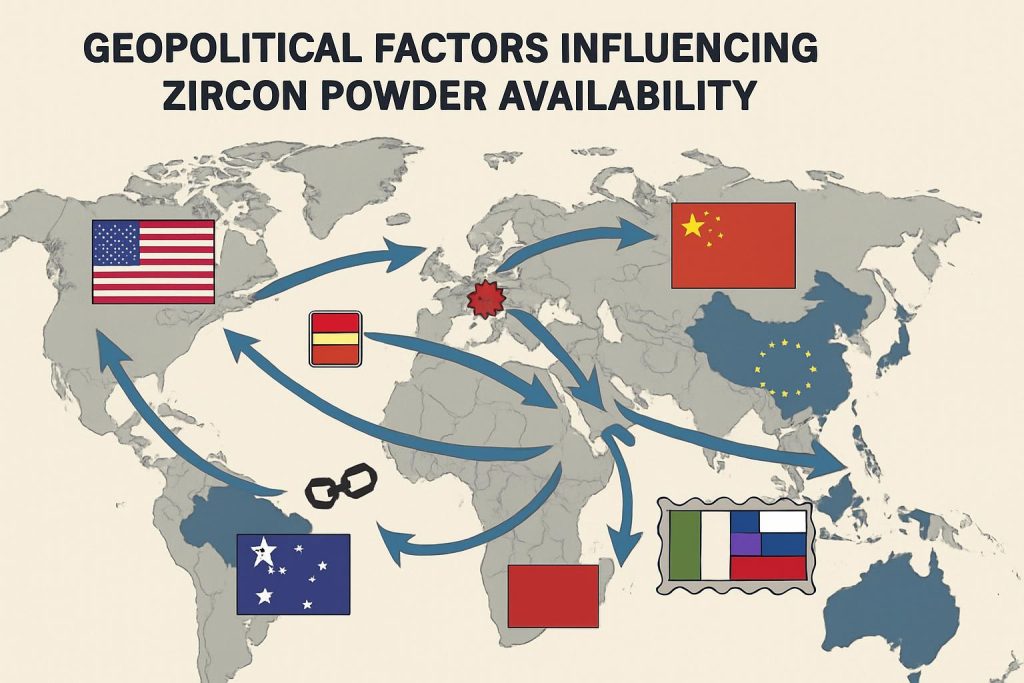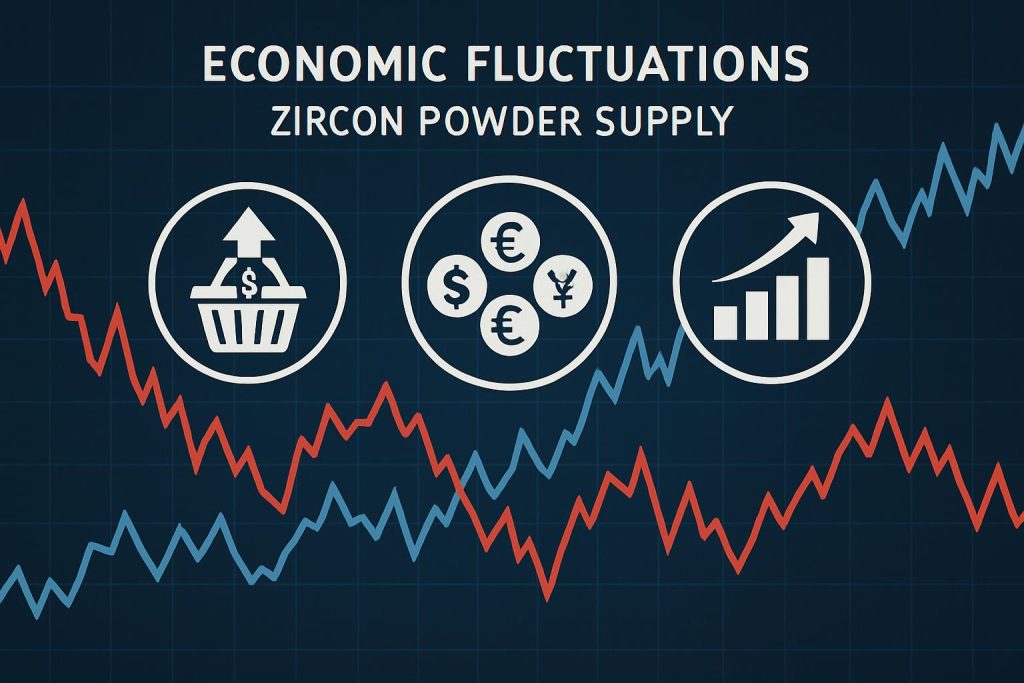Zircon powder is a vital industrial material, essential for ceramics, refractories, electronics, and nuclear industries due to its high melting point, chemical inertness, and thermal stability. Its global supply chain, a complex network of mining, processing, transportation, and distribution, is prone to disruptions. Understanding these vulnerabilities is crucial for purchasing managers to ensure a stable supply.
This article examines the critical supply chain challenges affecting international zircon powder trade, including global logistics, geopolitical shifts, environmental regulations, and economic fluctuations. By analyzing these factors, we aim to provide B2B buyers with a comprehensive overview to navigate complexities and build resilient supply strategies.
Primary Logistics Bottlenecks in Zircon Powder Distribution
The journey of zircon powder from mine to end-user is often challenging, with logistical hurdles impacting delivery times, costs, and supply reliability. Mitigating these effects begins with understanding the primary constraints.
Port Congestion and Shipping Delays
Major ports in key mining regions (e.g., Australia, South Africa) and consumption hubs (Asia, Europe) frequently experience congestion due to trade surges, labor shortages, or adverse weather. Vessel delays create ripple effects, extending lead times and increasing demurrage charges. Even minor disruptions can significantly impact specialized materials like zircon powder.
Container Shortages and Freight Rate Volatility
The COVID-19 pandemic exposed the fragility of global container logistics, leading to severe shortages and unprecedented freight rate spikes. While the crisis has eased, the market remains vulnerable. For bulk commodities like zircon powder, container availability and cost directly influence delivered price and supply predictability. Long-term contracts and diversified shipping routes can offer some protection.
Inland Transportation Infrastructure Limitations
Beyond sea freight, efficient inland transport (rail, road, barge) is crucial. In many mining regions, infrastructure is underdeveloped or prone to disruption (e.g., heavy rains halting raw material movement). Similarly, rail network limitations or truck driver shortages in consuming countries can create domestic bottlenecks. Robust multi-modal transport solutions are often necessary.
Customs and Border Control Complexities
Navigating international customs adds complexity, with each country having unique import/export procedures, tariffs, and documentation. Delays can stem from incomplete paperwork, new regulations, or increased scrutiny. For zircon powder, compliance with diverse international standards is critical to avoid costly hold-ups. Experienced logistics partners are invaluable.
Geopolitical Instability and Trade Routes
Geopolitical tensions and conflicts directly impact shipping lanes. Blockades, piracy, or regional conflicts can force longer, more expensive alternative routes, increasing transit times and fuel costs. Disruptions in key maritime chokepoints (e.g., Suez Canal) have far-reaching consequences. Diversifying sourcing and maintaining strategic inventories help mitigate these risks.
Table 1: Key Logistics Bottlenecks and Their Impact on Zircon Powder Supply
| Bottleneck Category | Specific Challenge | Impact on Supply Chain | Mitigation Strategy |
|---|---|---|---|
| Port & Shipping | Port Congestion | Extended lead times, increased demurrage | Diversify port usage, long-term shipping contracts |
| Container Shortages | Higher freight rates, reduced capacity | Strategic inventory, multi-modal transport | |
| Inland Transport | Infrastructure Limitations | Delays, higher domestic costs | Invest in robust logistics networks, local partnerships |
| Regulatory | Customs Complexities | Documentation delays, penalties | Expert customs brokerage, compliance management |
| Geopolitical | Trade Route Disruptions | Longer routes, increased costs, risk | Diversify sourcing, maintain strategic reserves |

Geopolitical Factors Influencing Zircon Powder Availability
The global zircon powder market is significantly shaped by geopolitical dynamics. Trade policies, international relations, and regional conflicts introduce uncertainties, affecting both supply and demand.
Trade Tariffs and Protectionist Policies
Governments may impose tariffs or protectionist policies to protect domestic industries or as a tool in international disputes. Such measures increase the cost of imported zircon powder, potentially making it unviable. Trade wars can disrupt established supply routes, forcing companies to seek more expensive alternatives. Monitoring evolving trade policies is essential for strategic sourcing.
Resource Nationalism and Export Restrictions
Mineral-rich countries may adopt resource nationalism, aiming for greater control over their wealth through increased export taxes, domestic processing requirements, or quotas. While intended to boost local industries, these policies can restrict global availability, leading to shortages and price hikes. Diversifying sourcing reduces dependence on any single nation’s policies.
International Sanctions and Political Instability
Sanctions on specific countries or entities can severely disrupt zircon powder flow if those regions are significant producers. Political instability, civil unrest, or conflicts in key mining areas can halt production and transport, causing immediate supply shocks. Robust risk assessment and contingency planning, including buffer stocks, are necessary.
Bilateral Relations and Diplomatic Tensions
Strained bilateral relations can indirectly impact trade, leading to slower customs or increased bureaucratic hurdles. This ‘soft power’ influence creates subtle but persistent disruptions. Building strong, diversified supplier relationships across different geopolitical landscapes is a prudent strategy.
Environmental Regulations and Mining Policies
Increased global environmental awareness has led to stricter mining and processing regulations. These include limits on extraction, mandates for eco-friendly techniques, or mining bans in sensitive areas. While beneficial, these regulations can reduce zircon supply and increase production costs. Companies must factor these evolving policies into long-term sourcing.

Economic Fluctuations and Zircon Powder Supply
The global economy’s volatility directly impacts industrial materials like zircon powder. Economic downturns, currency fluctuations, and inflation pose significant challenges for procurement.
Global Economic Recessions and Demand Slump
During recessions, industrial activity slows, decreasing demand for raw materials. For zircon powder, this means reduced orders. While seemingly easing supply pressures, it can lead to mine closures and reduced production, potentially causing shortages when demand recovers. Effective inventory management is crucial during these cycles.
Currency Exchange Rate Volatility
Zircon powder is often traded in U.S. dollars. Currency fluctuations significantly impact import costs and export profitability. A weakening local currency makes imports more expensive, while a strong local currency makes exports less competitive. Hedging strategies and diversified currency exposure can mitigate these financial risks.
Inflationary Pressures and Rising Production Costs
Global inflation, driven by energy prices, labor costs, or raw material scarcity, directly increases zircon powder production costs. These expenses are passed on to buyers, eroding profit margins. Long-term supply agreements with fixed pricing can offer stability against rising costs.
Interest Rate Changes and Investment Decisions
Changes in global interest rates affect borrowing costs. Higher rates can deter investment in new mining projects or infrastructure, limiting future supply growth. They also increase inventory holding costs, pushing companies towards leaner, more vulnerable strategies. Understanding these macroeconomic indicators is vital for long-term supply planning.
Commodity Price Volatility and Speculation
Zircon powder prices can be volatile due to market speculation, supply-demand imbalances, or geopolitical events. Rapid price swings complicate forecasting and budgeting. Diversified sourcing and long-term contracts can stabilize procurement costs and reduce exposure to short-term fluctuations.
Table 2: Economic Factors and Their Impact on Zircon Powder Supply Chain
| Economic Factor | Impact on Zircon Powder Supply | Mitigation Strategy |
|---|---|---|
| Recessions | Reduced demand, potential future supply shortages | Dynamic inventory management, market monitoring |
| Currency Volatility | Increased import costs, reduced export competitiveness | Currency hedging, diversified currency exposure |
| Inflation | Higher production costs, eroded profit margins | Long-term fixed-price contracts, cost optimization |
| Interest Rates | Reduced investment in new supply, higher inventory costs | Strategic capital planning, optimized inventory |
| Price Volatility | Unpredictable costs, budgeting challenges | Diversified sourcing, long-term agreements |

Environmental Regulations Affecting Zircon Powder Supply
Environmental concerns increasingly shape global industrial practices, including the zircon powder supply chain. Stricter regulations, driven by climate change and sustainability, present both challenges and opportunities.
Mining and Processing Environmental Standards
Governments are implementing stringent environmental standards for mining and mineral processing, covering water usage, waste disposal, air emissions, and land rehabilitation. Compliance requires significant investment, increasing operational costs. In some cases, new mining permits may be denied, impacting global raw zircon supply. Companies must prioritize suppliers with strong environmental compliance.
Carbon Emission Regulations and Logistics
Pressure to reduce carbon footprints leads to regulations impacting logistics and transportation, such as higher fuel taxes or mandates for cleaner fuels. For globally traded zircon powder, these increase freight costs and influence carrier choice. Companies increasingly seek suppliers committed to sustainable logistics and reduced carbon emissions.
Waste Management and Recycling Directives
Directives on industrial waste management and circular economy principles influence zircon-containing waste handling. This includes stricter rules on by-product disposal and emphasis on recycling. While beneficial, these regulations add complexity and cost, requiring new infrastructure. Innovative waste valorization can turn challenges into opportunities.
Water Usage and Pollution Controls
Water is critical in zircon mining and processing. Stricter regulations on abstraction, discharge quality, and pollution prevention are enforced globally. This can limit water availability or necessitate expensive treatment. Non-compliance leads to fines or shutdowns. Suppliers with advanced water management systems are attractive to environmentally conscious buyers.
Chemical Substance Regulations (e.g., REACH)
Regulations like REACH impact zircon powder trade, requiring extensive data on chemical properties and risks. Compliance can be complex and costly across jurisdictions. Ensuring suppliers adhere to relevant chemical regulations is crucial for uninterrupted supply and market access.
Impact of Supply Chain Disruptions on Zircon Powder End-Users
Disruptions in the zircon powder supply chain have far-reaching consequences for end-users, affecting production, costs, and competitiveness. Understanding these impacts is crucial for effective risk management.
Production Delays and Manufacturing Downtime
The most immediate impact is production delays. If zircon powder is not delivered on time, manufacturing lines can slow or halt, leading to costly downtime and missed targets. Even minor delays result in significant financial losses. Maintaining adequate safety stock buffers against such delays.
Increased Raw Material Costs and Price Volatility
Supply shortages drive up raw material prices. Constrained zircon powder availability can cause market price surges, directly increasing end-user production costs. This volatility complicates budgeting and erodes profit margins. Long-term supply contracts with agreed pricing can mitigate this risk.
Reduced Product Quality and Performance
Disruptions might force manufacturers to use alternative, lower-quality zircon powder or adjust formulations, compromising product quality. For critical applications, even slight variations can have significant consequences. Strict quality control for incoming materials is essential.
Loss of Market Share and Competitive Disadvantage
Repeated production delays or higher prices due to supply chain issues risk losing customers to competitors with stable, cost-effective supply chains. This can lead to long-term market erosion. Building resilient supply chains secures a sustainable competitive edge.
Damage to Brand Reputation and Customer Trust
Supply chain disruptions can damage brand reputation. Delays, inability to fulfill orders, or compromised quality lead to customer dissatisfaction and loss of trust. Proactive communication during disruptions helps manage expectations and preserve relationships.
Table 3: Impact of Zircon Powder Supply Chain Disruptions on End-Users
| Impact Category | Specific Consequence | Mitigation Strategy |
|---|---|---|
| Operational | Production Delays | Safety stock, diversified suppliers |
| Financial | Increased Costs | Long-term contracts, hedging |
| Quality | Reduced Product Quality | Strict QC, alternative material pre-qualification |
| Market | Loss of Market Share | Resilient supply chain, competitive pricing |
| Reputation | Damaged Brand Image | Proactive communication, strong customer service |
Strategies to Mitigate Zircon Powder Supply Chain Risks
Implementing robust risk mitigation strategies is crucial for a stable zircon powder supply, spanning sourcing, logistics, and relationship management.
Diversified Sourcing and Supplier Relationships
Reducing reliance on a single supplier or region is fundamental. Establishing relationships with multiple qualified suppliers across different countries buffers against localized disruptions. This diversification also fosters competition. Regular audits maintain these relationships.
Strategic Inventory Management and Buffer Stocks
For critical materials like zircon powder, maintaining strategic buffer stocks is vital. These reserves bridge gaps from delays or sudden demand surges. Optimal safety stock depends on lead times, demand variability, and holding costs. Advanced systems optimize these levels.
Enhanced Supply Chain Visibility and Data Analytics
End-to-end visibility across the supply chain is paramount, tracking materials from mine to delivery. Leveraging data analytics and real-time tracking provides early warnings of disruptions, enabling proactive intervention. This enhances decision-making, from optimizing logistics to adjusting production.
Collaboration and Partnerships Across the Value Chain
Building strong collaborative relationships with suppliers, logistics providers, and customers enhances resilience. Open communication and joint problem-solving lead to effective responses. Long-term partnerships secure preferential rates and capacity. Collaborating on demand forecasting aligns supply with needs.
Geopolitical and Market Intelligence Monitoring
Staying informed about global geopolitical developments, trade policy changes, and macroeconomic trends is critical. Market intelligence and regular risk assessments provide insights into potential disruptions. Proactive monitoring allows companies to anticipate challenges and develop contingency plans.
Emerging Technologies Shaping Zircon Powder Supply Chains
Innovation is transforming industrial processes, and emerging technologies offer solutions to enhance efficiency, transparency, and resilience in the zircon powder supply chain.
Blockchain for Traceability and Transparency
Blockchain offers enhanced traceability and transparency. Each transaction, from mining to delivery, is recorded on an immutable ledger, creating an unalterable record of origin and quality. This combats counterfeiting, verifies ethical sourcing, and builds trust. For B2B buyers, it means verifiable authenticity and compliance.
AI and Machine Learning for Demand Forecasting
AI and ML analyze vast datasets for accurate demand forecasts and disruption prediction. By identifying patterns in historical data, market trends, and events, AI anticipates demand fluctuations. This optimizes inventory, refines production, and adjusts sourcing, minimizing waste and ensuring timely supply.
IoT and Sensors for Real-time Monitoring
IoT and sensors enable real-time monitoring of shipments and storage conditions, tracking temperature, humidity, and location. This is valuable for sensitive materials, ensuring integrity and security. Real-time data empowers logistics managers to make informed decisions and provide accurate delivery estimates.
Advanced Robotics and Automation in Processing
Robotics and automation are increasingly deployed in zircon mining and processing. Automated systems handle hazardous materials, perform repetitive tasks with precision, and operate 24/7, increasing efficiency and safety. This enhances throughput and reduces human error, contributing to reliable supply.
Digital Twins for Supply Chain Optimization
Digital twins create virtual replicas of physical supply chains, allowing simulation of scenarios and identification of vulnerabilities. For zircon powder, a digital twin models the entire network, enabling predictive maintenance, optimized logistics, and rapid response planning, leading to a more resilient and efficient supply chain.
Table 4: Emerging Technologies and Their Impact on Zircon Powder Supply Chains
| Technology | Impact on Supply Chain | Benefit for Zircon Powder Trade |
|---|---|---|
| Blockchain | Enhanced traceability, transparency | Verifiable origin, ethical sourcing |
| AI/ML | Accurate demand forecasting, disruption prediction | Optimized inventory, proactive sourcing |
| IoT/Sensors | Real-time monitoring, condition tracking | Product integrity, secure transit |
| Robotics/Automation | Increased efficiency, improved safety | Consistent quality, reliable production |
| Digital Twins | Scenario simulation, optimization | Resilient network, efficient planning |
Conclusion
The international zircon powder trade faces complex supply chain challenges from logistics, geopolitics, economics, and environmental regulations. Navigating this requires a proactive approach from B2B buyers.
Implementing robust mitigation strategies—diversified sourcing, strategic inventory, and enhanced visibility—builds resilient supply chains. Embracing emerging technologies like blockchain, AI, IoT, robotics, and digital twins optimizes processes and enhances responsiveness.
Ensuring a stable zircon powder supply involves managing risks, fostering partnerships, leveraging technology, and maintaining awareness of the global environment. This secures access to critical material, maintains production, and sustains competitive edge.
FAQ Section
Q1: How much of the global zircon powder production is affected by supply chain disruptions annually?
While precise figures vary, significant supply chain disruptions can impact 10% to 25% of global zircon powder production and trade annually. This includes delays, increased costs, or temporary unavailability, highlighting the need for robust risk management.
Q2: How have recent global events, suchs as the pandemic, changed zircon powder transportation costs?
Recent global events, particularly the COVID-19 pandemic, caused unprecedented spikes in zircon powder transportation costs. Freight rates increased significantly due to port congestion, container shortages, and labor issues. While rates have stabilized somewhat, they remain elevated, and the market is susceptible to future volatility.
Q3: Which industries are most vulnerable to zircon powder supply chain disruptions?
Industries relying on high-purity or specialized zircon powder are most vulnerable, including advanced ceramics (dental, medical, aerospace) and high-performance refractories. These sectors have stringent quality requirements and tight schedules, making them sensitive to disruptions.
Q4: Are there viable alternative materials to zircon powder for critical applications?
Finding direct alternatives to zircon powder for critical applications is challenging due to its unique properties. While some alternatives exist (alumina, silicon carbide), they often involve trade-offs in performance or cost. Research continues, but zircon powder remains indispensable for its primary uses.
Q5: How can digital technologies improve the resilience of zircon powder supply chains?
Digital technologies significantly improve resilience. Blockchain enhances traceability. AI and ML provide accurate forecasting. IoT sensors enable real-time monitoring. Robotics and automation boost efficiency. Digital twins allow simulation and optimization, leading to proactive risk management and rapid response.




